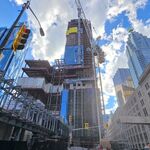I don't think the data trend backs up the "905 ghetto" hypothesis. The trend distinctly shows the 905 is getting poorer and the inner city is getting richer but the baseline levels are so much higher in the 905 that it will take a long time before they are at the same income levels. On the other hand because the central city includes so many tenants and single individual households we will likely not see central city neighbourhoods achieve household incomes similar to the more homogeneous single family enclaves in the suburbs.
On the other hand I think it is safe to say that some of the new "ghettos" in the GTA will form in the 905.
Much of the 905 is upper-middle class and there's many rungs to go down on the ladder before becoming ghetto, but there are parts of the 905 that are fairly blue collar now and did experience significant declines in income between the 2001 census and 2010 household survey. And after all, it's not like all of the outer (or inner) 416 is outright poor either, there's working class, middle class, even wealthy too.
Anyways, so what are the neighbourhoods that, if the 2001-2010 trends hold, would become rather poor by 2030? Median family income currently is I think around $70,000/year.
<$40,000, about like Jane-Finch (including the single family and semi detached homes in the neighbourhood)
-Miliken (Markham)
-Sandringham Wellington (Brampton)
-BramEast (Brampton)
-Malton (Mississauga)
<$50,000, which is roughly the median family income of Malvern and most of Scarborough more than 1-2km from Lake Ontario)
-Central Brampton (Steeles to Bovaird, 410 to Chingacousy)
-Central Mississauga (QEW to 403, Mavis to Cawthra)
<$55,000, which is roughly the average of Scarborough as a whole
-East Credit/Hurontario (Mississauga)
-Bram West/Fletcher's Meadow (Brampton)
-Bramalea
Brampton saw the steepest drop in median family income between 2001 and 2010 of any large community in Canada after Windsor, at about 20% (compared to about 8% drop for Scarborough). If these trends continue, pretty much only the Heart Lake area will be wealthier than Scarborough. And the fact that the new neighbourhoods it built from 2001 to 2010 (home to about 200,000 people) are already (on average) below the median and experienced a bit drop despite being new does raise questions. There's also Miliken (both Markham and Scarborough side) that saw huge drops in income and they're already relatively low income. Will the incomes in these neighbourhoods continue to drop, or will they stabilize? Getting to work by transit for people in these neighbourhoods might be more complicated than in places like Jane-Finch or Eglinton East. They're quite a bit further from the jobs in the core than Eglinton East, and even Jane-Finch is closer (and near the University-Spadina extension), plus there's a fair bit of working class jobs around Jane-Finch compared to Miliken and Brampton. There's also the issue of being served by a different transit agency.




